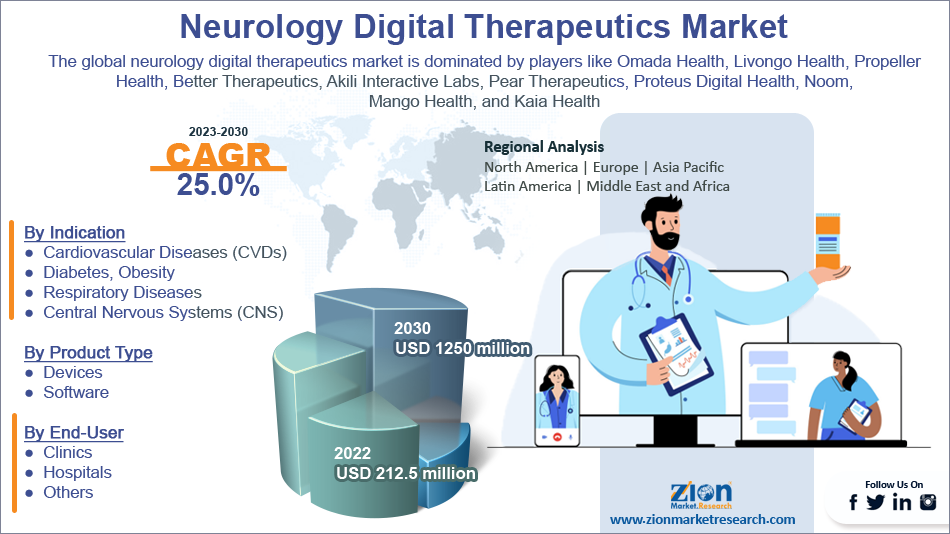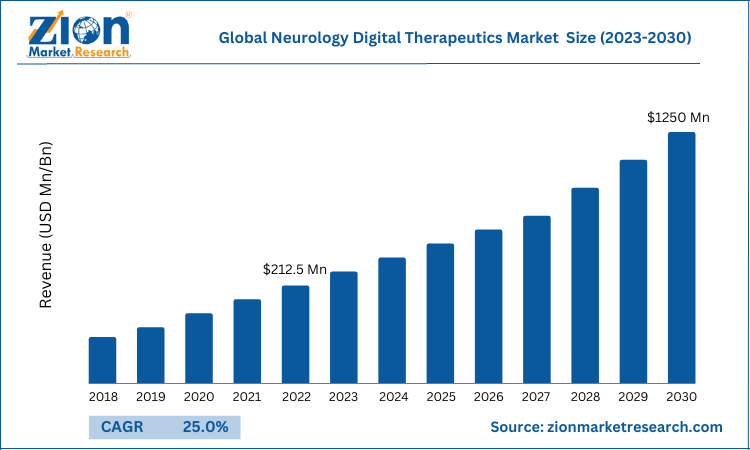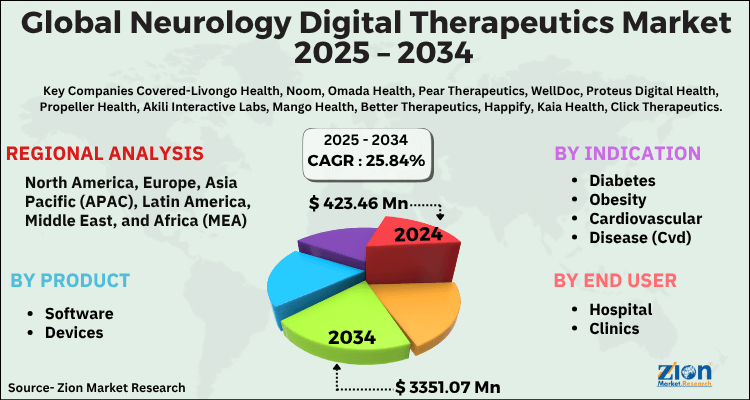Global Neurology Digital Therapeutics Market Size, Share, Growth Analysis Report - Forecast 2034

Neurology Digital Therapeutics Market By Product (Software, Devices), By Indication (Diabetes, Obesity, Cardiovascular, Disease (Cvd), Central Nervous System (Cns) Disease, Respiratory Disease, Others), By End User (Hospital, Clinics, Others), and By Region: Global and Regional Industry Overview, Market Intelligence, Comprehensive Analysis, Historical Data, and Forecasts 2025 - 2034
| Market Size in 2024 | Market Forecast in 2034 | CAGR (in %) | Base Year |
|---|---|---|---|
| USD 423.46 Million | USD 3351.07 Million | 25.84% | 2024 |
Global Neurology Digital Therapeutics Market: Industry Perspective
The global neurology digital therapeutics market size was worth around USD 423.46 Million in 2024 and is predicted to grow to around USD 3351.07 Million by 2034 with a compound annual growth rate (CAGR) of roughly 25.84% between 2025 and 2034. The report analyzes the global neurology digital therapeutics market's drivers, restraints/challenges, and the effect they have on the demands during the projection period. In addition, the report explores emerging opportunities in the neurology digital therapeutics industry.
The report analyzes the global neurology digital therapeutics market’s drivers, restraints/challenges, and the effect they have on the demands during the projection period. In addition, the report explores emerging opportunities in the neurology digital therapeutics market.
Global Neurology Digital Therapeutics Market: Overview
Neurology is a medicine brand that deals with the prevention, diagnosis, cure, and treatment of medical conditions associated with the nervous system which is a highly complex and critical part of a living organism responsible for coordinating sensory and action-oriented information with the help of signals that are transmitted across the body. The brand of medicine is responsible for investigating issues that arise in the brain, the spinal cord, and the peripheral nerves. Neuroscience forms the building block of neurology.
The medical professional that specializes in neurology is a neurologist, and they treat various critical conditions like seizures, stroke, disorders related to body movement like Parkinson's disease, and multiple sclerosis, to name a few. They may also be involved in various research, and clinical trials related to the field to support further development. Digital therapeutics is a part of advancing digital healthcare which involves using advanced technology to administer data-based medical care. It comprises technology-driven prevention, management, or treatment of diseases or conditions.
They may either be used independently or along with other medical devices depending on the requirement of the patient's treatment plan but the intention is always to optimize the medical care provided. As per experts and studies, digital therapeutics is expected to aid greatly in treating chronic disabling diseases. Digital therapeutics comes with its own set of advantages since it allows patients to improve their medical adherence capabilities by employing personalized and customized alerts or pushing factors that encourage changes in the long-term behavior toward self-care amongst patients.
This becomes extremely important in the case of diseases like diabetes, blood pressure issues, and others where the time of the dose and interval between doses, amongst other factors, are extremely critical for the overall well-being of the person under medical care.
 Request Free Sample
Request Free Sample
Global Neurology Digital Therapeutics Market: Growth Drivers
Growing advancements in the medical field to propel market growth
The global neurology digital therapeutics market is projected to grow owing to the rising trend of adapting advanced technology in the healthcare segment across regions. With the growing number of diseases that are extremely new to the medical community along with mutations in the already existing medical conditions with no cure as of current times has propelled healthcare and pharmaceutical players to opt for the advancing technology in the medical sector to enhance the medical care provided to the patients.
As a consequence, every medicinal sub-units is investing in technologies that can help reach the goal and so is the neurology segment, which deals with some of the long-existing concerns with no concrete treatment plan. Generally, patients suffering from neurological conditions require external help for proper medicinal adherence and digital therapeutics have proven to help establish the necessary routine. As per a Mckinsey report published in 2020, the US healthcare sector had increased its spending on digital therapeutics by 40% from the last seven years, as of 2018 with a total value reaching up to USD 1 billion.
One of the major reasons for the same is the well-established positive outcomes recorded by the use of digital therapeutics thus raising the confidence of the healthcare providers and that of the patients in using the technology to its true potential. Diseases that are complex and need more than human intervention can only be treated by employing both human knowledge and technological capabilities in the future and it is projected to help the global market expansion during the projection period
Restraints:
High cost of technology to restrict the market growth
The key deliverable of an effective healthcare program is the accessibility to the treatment and its effectiveness. The cost of employing digital therapeutics in treating neurological conditions is high in current times which is caused by the limited availability of the technology in the growing economies. The devices can only be adopted by people in the higher income group or medical facilities with large funds allowing them the facility to be equipped with the devices. Treatment of neurological conditions in itself is expensive and deploying advanced technology can result in increased overall costs. These factors are projected to restrict the neurology digital therapeutics industry growth.
Opportunities:
Growing research & development to provide market growth opportunities
Since the use of digital therapeutics in neurology is showing promising signs, the global market is witnessing huge support from the government and private agencies in terms of robust R&D to establish more information on the use of devices as well as ways of making the technology more accessible by improving healthcare funds or generating awareness about the use of the technology. These factors are expected to help the global neurology digital therapeutics market gather more growth opportunities.
Challenges:
Issues related to improving the efficacy of the devices to pose challenges in the market
Initially, the global market suffered challenges like patient acceptance, regulatory concerns, and payer adoption. However, studies have shown the current challenge with digital therapeutics is majorly concentrated on manufacturers' fronts who are struggling with improving the efficacy of the device owing to enhanced consumer expectations and requirements which can only be improved with more R&D in the field.
Key Insights
- As per the analysis shared by our research analyst, the global neurology digital therapeutics market is estimated to grow annually at a CAGR of around 25.84% over the forecast period (2025-2034).
- Regarding revenue, the global neurology digital therapeutics market size was valued at around USD 423.46 Million in 2024 and is projected to reach USD 3351.07 Million by 2034.
- The neurology digital therapeutics market is projected to grow at a significant rate due to increasing adoption of digital health solutions, rising neurological disorder prevalence, advancements in AI and wearable tech, and supportive regulatory frameworks.
- Based on Product, the Software segment is expected to lead the global market.
- On the basis of Indication, the Diabetes segment is growing at a high rate and will continue to dominate the global market.
- Based on the End User, the Hospital segment is projected to swipe the largest market share.
- Based on region, North America is predicted to dominate the global market during the forecast period.
Global Neurology Digital Therapeutics Market: Report Scope
| Report Attributes | Report Details |
|---|---|
| Report Name | Neurology Digital Therapeutics Market |
| Market Size in 2024 | USD 423.46 Million |
| Market Forecast in 2034 | USD 3351.07 Million |
| Growth Rate | CAGR of 25.84% |
| Number of Pages | 198 |
| Key Companies Covered | Livongo Health, Noom, Omada Health, Pear Therapeutics, WellDoc, Proteus Digital Health, Propeller Health, Akili Interactive Labs, Mango Health, Better Therapeutics, Happify, Kaia Health, Click Therapeutics, and others. |
| Segments Covered | By Product, By Indication, By End User, and By Region |
| Regions Covered | North America, Europe, Asia Pacific (APAC), Latin America, The Middle East and Africa (MEA) |
| Base Year | 2024 |
| Historical Year | 2020 to 2023 |
| Forecast Year | 2025 - 2034 |
| Customization Scope | Avail customized purchase options to meet your exact research needs. Request For Customization |
Global Neurology Digital Therapeutics Market: Segmentation
The global neurology digital therapeutics market is segmented by indication, product type, end-user, and region. All the segments have been analyzed based on present and future trends and the market is estimated from 2025 to 2034.
Based on indication, the global market is segmented into cardiovascular diseases (CVDs), diabetes, obesity, respiratory diseases, and central nervous systems (CNS). The global market is currently led by the diabetes segment owing to the advantages of digital therapeutics in medication adherence in diabetic patients. The rising number of people with sugar-level concerns is expected to help segmental growth in the coming years. As per the Centers for Disease Control & Prevention, there are 415 million affected by the disease as of 2022 and the number is projected to reach more than half of a billion by 2040.
Based on product type, the neurology digital therapeutics industry is divided into devices and software. Currently, the highest generating segment is the software section as more companies are developing applications to help control medical conditions. As of 2022, the US Food & Drugs Administration had approved around 40 digital therapeutics.
Based on end-user, the global market segments are clinics, hospitals, and others. The fastest growing segment is hospitals since more patients rely on hospital facilities for treatment and they also have the necessary funds to adopt better technologies in the medical care process. In the 2022-2023 budget of the Australian government, they announced that around AUD 107.2 million will be spent on modernizing the healthcare system of the country.
The Regional, this segment includes the current and forecast demand for North America, Europe, Asia Pacific, Latin America,and the Middle East and Africa.
Recent Developments:
- In August 2024, Better Therapeutics launched a new and more debate-focused digital therapeutic which will improve A1c. The recently launched product is influenced by techniques applied in therapies related to cognitive behavior. It will be prediction based and is expected to help diabetic patients to change their behavior and eating habits to bring A1c levels under control.
- In September 2024, Neuroglee, a digital therapeutics startup raised USD 10 million from Openspace ventures & EDBI. The company is expected to use the raised fund to launch digital neurology clinics along with helping Neuroglee enter the Boston market.
Global Neurology Digital Therapeutics Market: Regional Analysis
The Neurology Digital Therapeutics market shows strong regional dynamics, with North America leading due to advanced healthcare infrastructure, high adoption of digital health solutions, and significant investments in neurological disorder management. Europe follows closely, driven by increasing prevalence of neurological conditions, supportive regulatory frameworks for digital therapeutics, and growing awareness among patients and providers. The Asia-Pacific region is emerging rapidly, fueled by expanding healthcare access, rising smartphone penetration, and government initiatives promoting digital health, especially in countries like China, Japan, and India. Meanwhile, Latin America and the Middle East & Africa are witnessing gradual growth, supported by improving healthcare systems and rising focus on innovative treatments for neurological diseases, though adoption remains comparatively slower due to economic and infrastructural challenges.
Global Neurology Digital Therapeutics Market: Competitive Analysis
The report provides a company market share analysis to give a broader overview of the key market players. In addition, the report also covers key strategic developments of the market, including acquisitions & mergers, new product launches, agreements, partnerships, collaborations & joint ventures, research & development, and regional expansion of major participants involved in the neurology digital therapeutics market on a global and regional basis.
The global neurology digital therapeutics market is dominated by players like:
- Livongo Health
- Noom
- Omada Health
- Pear Therapeutics
- WellDoc
- Proteus Digital Health
- Propeller Health
- Akili Interactive Labs
- Mango Health
- Better Therapeutics
- Happify
- Kaia Health
- Click Therapeutics
Global Neurology Digital Therapeutics Market: Segmentation Analysis
The global neurology digital therapeutics market is segmented as follows;
By Product
- Software
- Devices
By Indication
- Diabetes
- Obesity
- Cardiovascular
- Disease (Cvd)
- Central Nervous System (Cns) Disease
- Respiratory Disease
- Others
By End User
- Hospital
- Clinics
- Others
Global Neurology Digital Therapeutics Market: Regional Segment Analysis
- North America
- The U.S.
- Canada
- Mexico
- Europe
- France
- The UK
- Spain
- Germany
- Italy
- Rest of Europe
- Asia Pacific
- China
- Japan
- India
- Australia
- South Korea
- Rest of Asia Pacific
- The Middle East & Africa
- Saudi Arabia
- UAE
- Egypt
- Kuwait
- South Africa
- Rest of the Middle East & Africa
- Latin America
- Brazil
- Argentina
- Rest of Latin America
Table Of Content
Methodology
FrequentlyAsked Questions
Neurology is a medicine brand that deals with the prevention, diagnosis, cure, and treatment of medical conditions associated with the nervous system which is a highly complex and critical part of a living organism responsible for coordinating sensory and action-oriented information with the help of signals that are transmitted across the body. The brand of medicine is responsible for investigating issues that arise in the brain, the spinal cord, and the peripheral nerves. Neuroscience forms the building block of neurology.
The global neurology digital therapeutics market is expected to grow due to rising prevalence of neurological disorders, advancements in digital health technologies like AI and wearables, increasing demand for remote patient monitoring, and growing emphasis on personalized and cost-effective treatment options.
According to a study, the global neurology digital therapeutics market size was worth around USD 423.46 Million in 2024 and is expected to reach USD 3351.07 Million by 2034.
The global neurology digital therapeutics market is expected to grow at a CAGR of 25.84% during the forecast period.
North America is expected to dominate the neurology digital therapeutics market over the forecast period.
Leading players in the global neurology digital therapeutics market include Livongo Health, Noom, Omada Health, Pear Therapeutics, WellDoc, Proteus Digital Health, Propeller Health, Akili Interactive Labs, Mango Health, Better Therapeutics, Happify, Kaia Health, Click Therapeutics, among others.
The report explores crucial aspects of the neurology digital therapeutics market, including a detailed discussion of existing growth factors and restraints, while also examining future growth opportunities and challenges that impact the market.
RelatedNews
HappyClients
Zion Market Research
Tel: +1 (302) 444-0166
USA/Canada Toll Free No.+1 (855) 465-4651
3rd Floor,
Mrunal Paradise, Opp Maharaja Hotel,
Pimple Gurav, Pune 411061,
Maharashtra, India
Phone No +91 7768 006 007, +91 7768 006 008
US OFFICE NO +1 (302) 444-0166
US/CAN TOLL FREE +1 (855) 465-4651
Email: sales@zionmarketresearch.com
We have secured system to process your transaction.
Our support available to help you 24 hours a day, five days a week.
Monday - Friday: 9AM - 6PM
Saturday - Sunday: Closed






